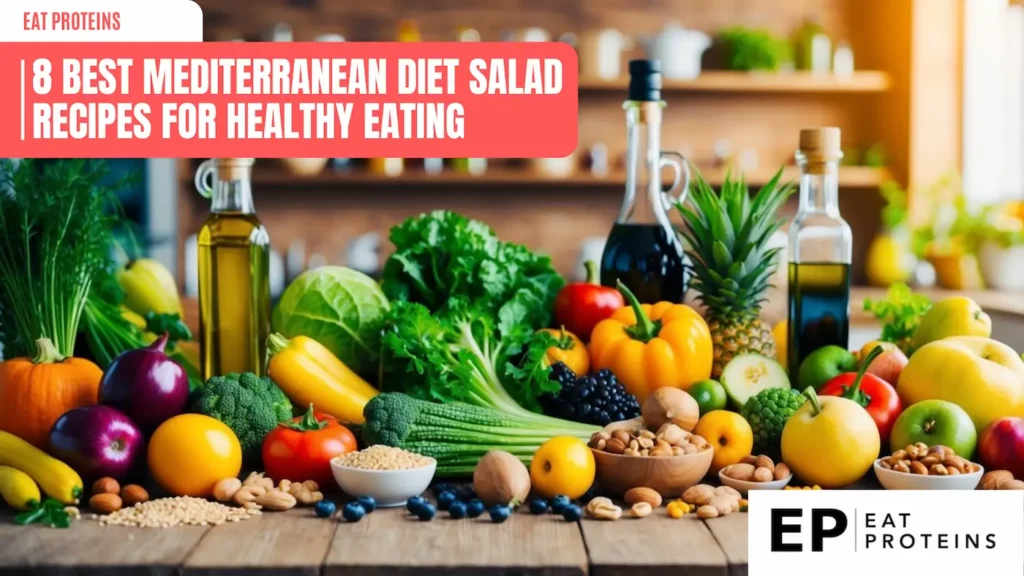
Eating a Mediterranean diet can be a delicious way to stay healthy. This diet emphasizes fresh fruits, vegetables, whole grains, and healthy fats. I believe that trying different salad recipes is a great way to enjoy these nutritious foods while adding variety to your meals.
In this article, I will share some of my favorite Mediterranean diet salad recipes. These dishes are not only vibrant and tasty but also easy to prepare. Each recipe showcases the fresh ingredients that make up the Mediterranean way of eating.
1. Greek Chickpea Salad
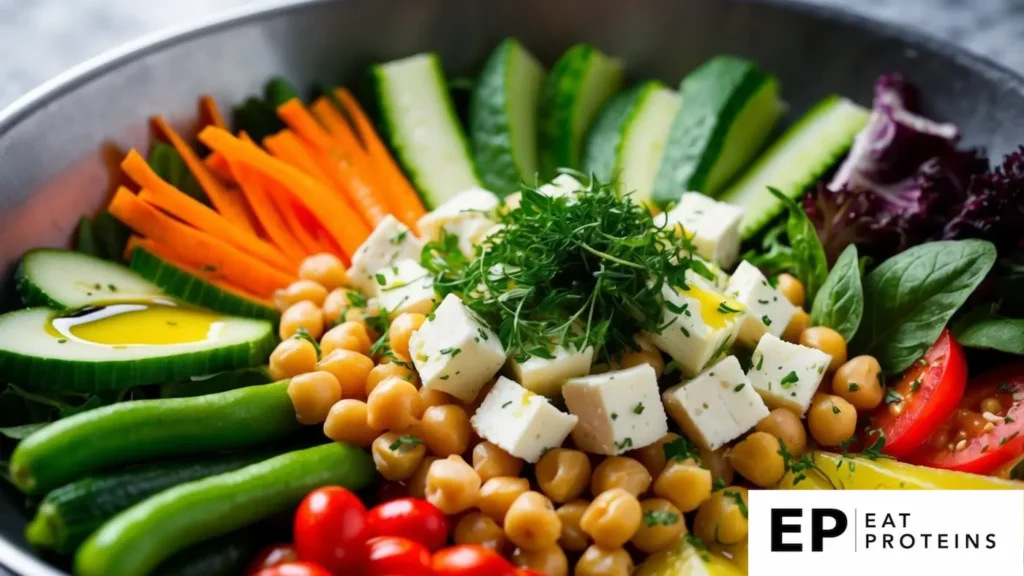
I love making Greek Chickpea Salad for a healthy and tasty meal. This salad is easy to prepare and packed with nutritious ingredients. Chickpeas are high in protein and fiber, making this dish a satisfying option.
To make Greek Chickpea Salad, I gather the following ingredients: canned chickpeas, diced cucumber, tomatoes, red onion, bell pepper, olives, and feta cheese. For the dressing, I use olive oil, lemon juice, salt, and pepper.
Here are the steps to prepare the salad:
- Rinse and drain one can of chickpeas.
- Chop one cucumber, one tomato, half a red onion, and half a bell pepper.
- Slice a handful of olives and crumble some feta cheese.
- In a large bowl, combine all the ingredients.
- In a small bowl, whisk together three tablespoons of olive oil and the juice of one lemon. Season with salt and pepper.
- Pour the dressing over the salad and toss gently.
This salad can be served immediately or chilled for enhanced flavors. I often enjoy it as a standalone dish or a side with grilled meat.
2. Mediterranean Quinoa Salad
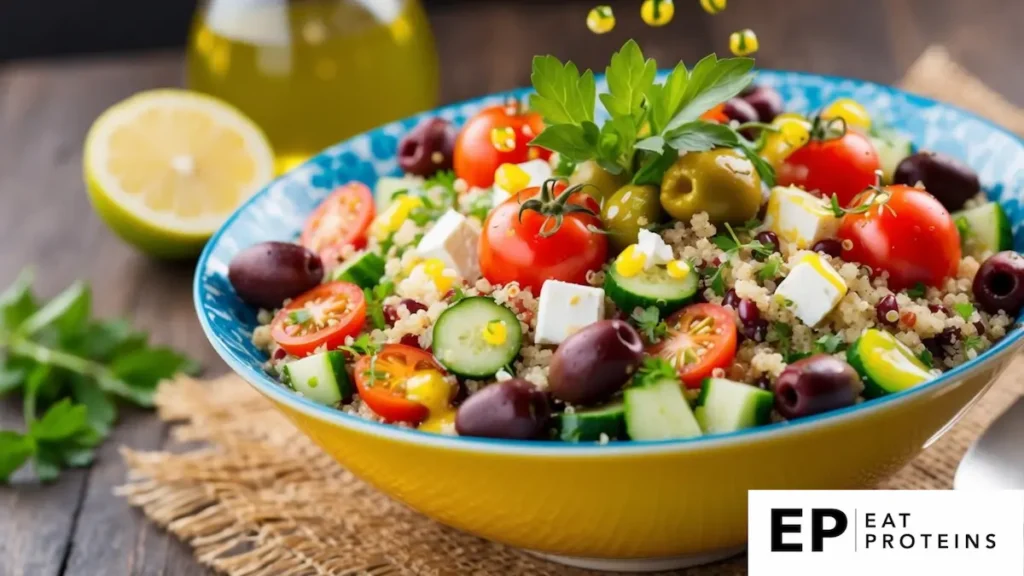
Mediterranean quinoa salad is a nutritious and tasty dish that combines vibrant flavors and healthy ingredients. Quinoa is a seed that cooks quickly and provides a good amount of protein. This salad is easy to make and perfect for a light meal or side dish.
To prepare, I follow these simple steps:
- Cook the quinoa: Rinse 1 cup of quinoa under cold water. In a pot, combine it with 2 cups of water or broth. Bring to a boil, then reduce heat and simmer for about 15 minutes until fluffy.
- Prepare the vegetables: Dice 1 cucumber, chop 1 bell pepper, and slice 1 cup of cherry tomatoes in half.
- Mix the salad: In a large bowl, combine the cooked quinoa, diced vegetables, and ½ cup of chopped parsley.
- Add dressing: In a small bowl, whisk together 3 tablespoons of olive oil, the juice of 1 lemon, salt, and pepper to taste. Pour it over the salad and mix well.
- Serve: Enjoy the salad chilled or at room temperature.
This salad showcases the Mediterranean diet’s focus on fresh ingredients and can be customized with additional items like olives or feta cheese if desired.
3. Tabbouleh Salad
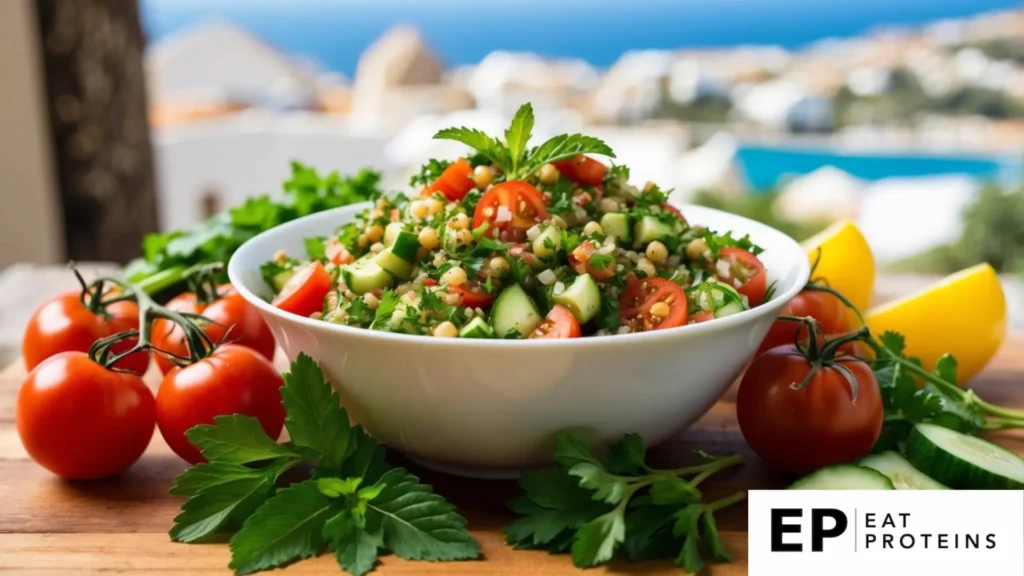
Tabbouleh is a refreshing salad that originates from the Middle East, particularly Lebanon. It is primarily made from parsley, bulgur, tomatoes, and a simple lemon-olive oil dressing. This salad is not just flavorful but also nutritious.
I find tabbouleh easy to make. The steps are straightforward and it comes together quickly.
Here’s how I prepare it:
- Ingredients Preparation: Rinse and chop 1 cup of fresh parsley and 1 medium tomato. Soak 1/2 cup of bulgur in water for about 30 minutes, then drain.
- Mixing: In a large bowl, combine the chopped parsley, tomato, and bulgur.
- Dressing: In a small bowl, mix 1/4 cup of olive oil and the juice of 1 lemon. Pour this dressing over the salad.
- Seasoning: Add salt and pepper to taste. Toss everything well to ensure all the ingredients are combined.
- Chill: Let it sit for about 15 minutes in the refrigerator before serving to enhance the flavors.
This dish is perfect as a side or a light meal.
4. Turkish Cucumber Salad

Turkish Cucumber Salad, known as “Cacik,” is a refreshing dish that highlights cucumbers alongside yogurt and herbs. It’s a light and healthy option ideal for any meal.
Making this salad is easy and requires a few fresh ingredients. I enjoy its crisp texture and tangy flavor. Here’s how to prepare it.
- Start with two medium cucumbers. Peel and slice them thinly.
- In a bowl, add one cup of plain yogurt.
- Mix in two minced garlic cloves and one tablespoon of olive oil.
- Combine the cucumbers into the yogurt mixture.
- Season with salt, pepper, and a sprinkle of dried or fresh dill.
- Stir everything well and let it chill for 15 minutes before serving.
This salad pairs wonderfully with grilled meats and pita bread. It’s light, tasty, and full of nutrients.
5. Lentil Salad with Feta
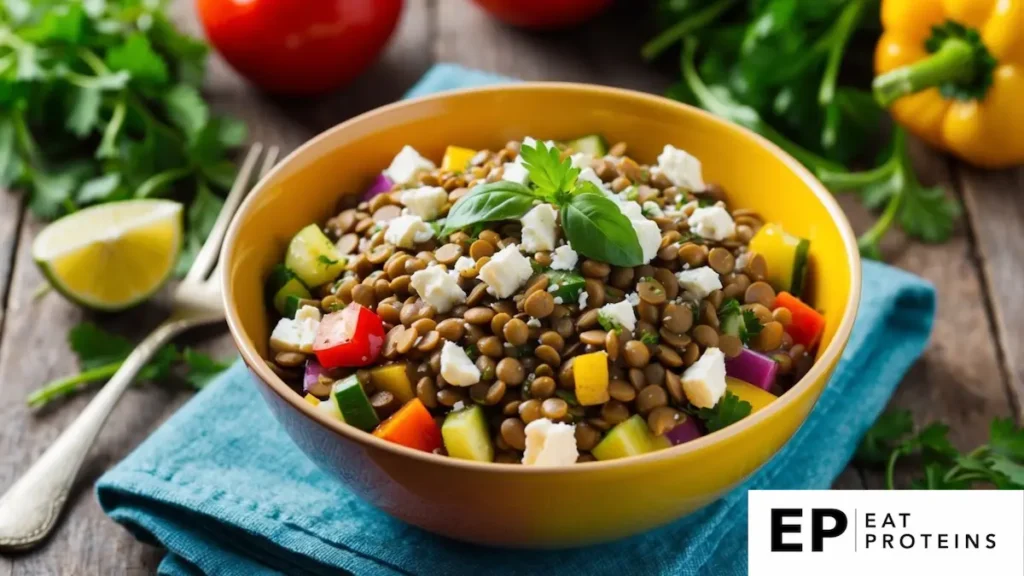
Lentil Salad with Feta is a nutritious dish that combines protein-rich lentils with creamy feta cheese. This salad is not only filling but also packed with flavor.
I find this salad easy to make. It takes about 30 minutes to prepare and cook. Here are the steps I follow:
- Cook the Lentils: Start by rinsing 1 cup of lentils, then boil them in 3 cups of water for about 20 minutes until tender. Drain and let them cool.
- Prepare the Vegetables: While the lentils cook, chop 1 cucumber, 1 bell pepper, and 1 small red onion.
- Make the Dressing: In a bowl, whisk together 3 tablespoons of olive oil, 2 tablespoons of lemon juice, and a pinch of salt and pepper.
- Combine the Ingredients: In a large bowl, mix the cooked lentils, chopped vegetables, and 1 cup of crumbled feta cheese.
- Toss and Serve: Pour the dressing over the salad, toss gently, and serve chilled or at room temperature.
This salad is versatile. I often add herbs like parsley or mint for extra flavor.
6. Moroccan Carrot Salad

Moroccan Carrot Salad is a fresh and flavorful dish. It combines simple ingredients like carrots, spices, and lemon juice. This salad is vibrant and full of nutrition.
Making this salad is quite easy. It takes about 15 minutes to prepare. I appreciate how quickly I can whip it up for a meal.
Here are the steps:
- Peel and slice 4 large carrots into thin rounds.
- Steam the carrots for about 5 minutes until tender but still crisp.
- In a bowl, mix together the juice of 1 lemon, 2 tablespoons of olive oil, 1 teaspoon of cumin, and salt to taste.
- Add the steamed carrots to the bowl and toss until well coated.
- Finish by adding chopped fresh parsley for garnish.
This salad has a nice balance of sweet and tangy flavors. It works great as a side dish or light lunch. I love how it brings a taste of Morocco to my table.
7. Panzanella Salad

Panzanella is a traditional Italian salad made with fresh bread and ripe tomatoes. It combines simple ingredients for a refreshing dish that’s perfect for warm days.
Making Panzanella is easy and quick. I love how it allows me to use leftover bread. It only takes about 15 minutes to prepare.
To make Panzanella, follow these steps:
- Gather Ingredients: I need stale bread, ripe tomatoes, cucumbers, red onion, basil, olive oil, vinegar, salt, and pepper.
- Prepare Bread: I cut the bread into cubes and toast them lightly in the oven until golden, about 8 minutes.
- Chop Vegetables: I chop the tomatoes, cucumbers, and onion.
- Mix Ingredients: In a large bowl, I combine the toasted bread, chopped vegetables, and torn basil leaves.
- Dress the Salad: I drizzle olive oil and vinegar over the mixture, then season it with salt and pepper to taste.
- Toss and Serve: I gently toss everything together and let it sit for about 10 minutes to soak in the flavors.
Panzanella is a flavorful salad that perfectly showcases Mediterranean ingredients.
8. Mediterranean Orzo Pasta Salad

Mediterranean Orzo Pasta Salad is a fresh and colorful dish that celebrates the flavors of the Mediterranean. It combines orzo pasta with various vegetables, herbs, and a simple dressing.
I find this salad easy to make and perfect for any meal. To prepare, I start by cooking 8 ounces of orzo pasta according to package instructions. It usually takes about 8-10 minutes.
While the pasta cooks, I chop ingredients like cherry tomatoes, cucumber, and bell peppers. This adds crunch and vibrant colors to the salad. I also like to include Kalamata olives and feta cheese for extra taste.
Once the orzo is ready, I drain it and let it cool for a few minutes. Then, I mix all the chopped vegetables with the orzo in a large bowl.
For the dressing, I whisk together olive oil, lemon juice, salt, and pepper. I pour this over the salad and toss everything gently. This salad can be served immediately or chilled in the fridge for an hour.
In just a few steps, I can enjoy a delicious Mediterranean dish that’s great for lunch or dinner.
What Are the Health Benefits of Mediterranean Diet Salads?

Mediterranean diet salads offer various health benefits that enhance overall well-being. They are packed with nutrients, support weight management, and promote heart health. These advantages come from the rich ingredients typically found in these salads.
What Are the Nutritional Advantages?
The Mediterranean diet is known for its rich nutrient profile. Ingredients like leafy greens, tomatoes, cucumbers, and olives provide essential vitamins and minerals. For example:
- Leafy Greens: High in vitamins A, C, and K.
- Tomatoes: Rich in lycopene, which may have antioxidant properties.
- Olives: Packed with healthy monounsaturated fats.
Adding nuts and seeds boosts protein and provides fiber, which helps in digestion. This combination makes Mediterranean salads satisfying and nourishing, keeping me energized throughout the day.
How Does It Help with Weight Management?
Mediterranean salads can play a significant role in maintaining a healthy weight. The high fiber content from vegetables and legumes increases feelings of fullness. For instance, beans and chickpeas are excellent for this purpose. They are low in calories but high in nutrients.
Incorporating olive oil as a dressing adds healthy fats that are essential for the body. The right balance of fats, proteins, and carbohydrates in these salads helps curb cravings. This balanced approach can make it easier for me to stick to my weight management goals.
How Does It Improve Heart Health?
Eating Mediterranean diet salads can support heart health. Many ingredients found in these salads, like fresh vegetables and olive oil, are known to improve cardiovascular health. Studies have shown that the Mediterranean diet can lower blood pressure and reduce cholesterol levels.
Foods like nuts and fish, often included in Mediterranean meals, are rich in omega-3 fatty acids. These fats are beneficial for heart function. As I enjoy a salad, I’m not just treating my taste buds, but I’m also caring for my heart.
What Are the Key Ingredients in Mediterranean Salad Recipes?
Mediterranean salads are known for their vibrant flavors and health benefits. Key ingredients enhance nutritional value while adding delicious taste and texture. The focus in these salads is often on fresh vegetables, healthy fats, and plant-based proteins.
What Fresh Vegetables Are Used?
I emphasize using a variety of fresh vegetables in Mediterranean salads. Common choices include tomatoes, cucumbers, bell peppers, and red onions. These vegetables not only provide essential vitamins and minerals but also add crunch and color to the dish.
Here are some popular options:
- Tomatoes: Rich in vitamin C and antioxidants.
- Cucumbers: Hydrating and low in calories.
- Bell Peppers: High in vitamin A and vitamin C.
I often recommend incorporating leafy greens like arugula or spinach for added nutrients. Fresh herbs, such as parsley and basil, can enhance flavor and freshness too.
What Healthy Fats Are Included?
Healthy fats are a cornerstone of Mediterranean diets. I mainly use extra virgin olive oil as the primary fat. This oil is rich in monounsaturated fats, which support heart health. It also provides antioxidants that help reduce inflammation.
Other sources of healthy fats include:
- Avocados: Creamy and nutrient-dense.
- Nuts and Seeds: Almonds and sunflower seeds offer protein and fiber.
Drizzling olive oil over a salad not only enhances flavor but also helps absorb the nutrients in vegetables better.
What Plant-Based Proteins Are Common?
In Mediterranean salads, I like to include plant-based proteins for a filling meal. Options such as chickpeas, lentils, and beans provide fiber and essential nutrients.
Here are some great choices:
- Chickpeas: A good source of protein and iron.
- Lentils: High in fiber and can help regulate digestion.
- Feta Cheese: While not plant-based, it is often used to add flavor and protein.
These ingredients boost the salad’s protein content while keeping it light. Combining these proteins with vegetables creates a balanced, healthy meal.
How Can You Prepare Mediterranean Salads?
Creating delicious Mediterranean salads relies on proper ingredient selection and flavor balance. I find that using fresh, high-quality ingredients makes a significant difference in taste and nutrition. Here are some key guidelines to follow.
How to Choose the Right Ingredients?
When I prepare Mediterranean salads, I focus on fresh vegetables. Ingredients like tomatoes, cucumbers, bell peppers, and red onions are staples. They provide a vibrant color and variety of textures.
I prefer using seasonal produce whenever possible. This not only enhances the flavor but also adds nutrients.
In addition to vegetables, I often include proteins like chickpeas, feta cheese, or grilled chicken. Legumes provide fiber, while cheese adds creaminess.
Don’t forget to include healthy fats. Ingredients like olives and avocado not only boost flavor but also contribute healthy monounsaturated fats.
How to Balance Flavors?
Balancing flavors is crucial in Mediterranean salads. I aim for a mix of sweet, salty, sour, and bitter elements. For instance, I often pair ripe tomatoes for sweetness with tangy feta cheese for saltiness.
Using fresh herbs, such as basil, parsley, or oregano, can enhance the flavor profile significantly. I add these herbs to provide freshness and aroma.
Moreover, a good dressing plays a key role. I prefer a simple mix of olive oil, lemon juice, salt, and pepper. This dressing keeps the flavors bright without overpowering the salad.
Lastly, considering texture is important. Combining crunchy vegetables with creamy cheese or creamy dressings can create a satisfying experience.
